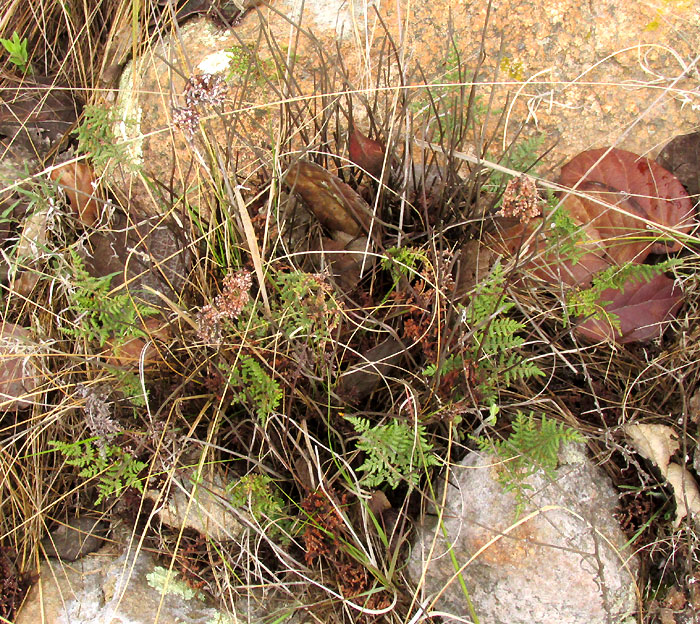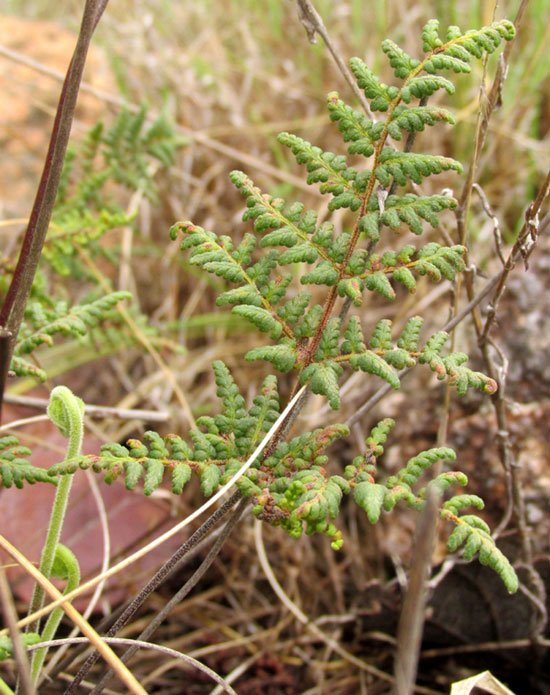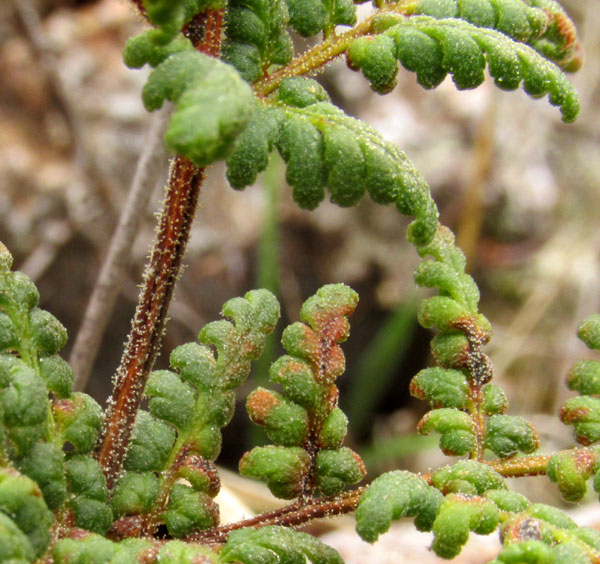Excerpts from Jim Conrad's
Naturalist Newsletter
entry from field notes dated July 3, 2022, taken on the eastern lower slope of Cerro de la Cruz, at an elevation of ~2700m (~8850 ft), just south of the community of El Pinar, Amealco de Bonfil, Querétaro, MÉXICO, (~N20.17°, ~W100.17°)
GLANDULAR LIP FERN

On the lower eastern slope of Cerro de la Cruz where the valley floor begins and the oak forest transitions to open grassy, scrubland, the above ferns arose from among a heap of rhyolite stones maybe left there from an abandoned building project long ago. Somehow the little colony struck me as looking particularly comfortably at home there, the rocks, grass, scattered dried leaves and ferns presenting a kind of aesthetically pleasing floral arrangement.

Individual fronds formed broad isosceles triangles, their determined symmetry contrasting with the randomness of rocks and scattered leaves, and the freedom expressed by grass. Yet frond symmetry was in context of fragile, graceful fiddleheads unfolding at the picture's lower left.
But here we're into a different music, that of who and so-what, so now into details of that:

Up close, one sees brown spots forming, probably the consequence of the unusually severe, protracted dry season. And lots of white dots cover everything, the dots being glands atop stubby hairs. Having such a thick covering is a distinctive field mark, and another is the conspicuous groove running atop the frond's midrib, or rachis, and the rachis's branches, the rachillae. Most ferns don't have such a triangular shape, such striking glands, and such grooves in their stems.

Above, with the pinnules' margins so emphatically curving down, forming shelter in which spore-producing sporangia may form, it's clear that we have yet another lip fern, genus Hemionitis. Moreover, despite there being about 30 lip fern species native to our upland, central Mexican region known as the Bajío, the features noted above make this an easy species to identify. It's HEMIONITIS KAULFUSSII, in English sometimes known as the Glandular Lip Fern.
An English name is available because the species is distributed from southwestern Texas south throughout Mexico's upland semiarid zones, through Central America into Colombia, northwestern South America. It likes rocky canyons, arroyo banks, mountain slopes with outcroppings of igneous rocks, forests of oak and pine, scrub and grasslands, so our plants have reason to look at ease where they are. In Mexico they occur from 1850-2600m (6050-9000 feet) in elevation.
Interestingly, a 1982 study by DM Benham found that the species produces 32 spores per sporangium, and reproduce apogamously. Apogamy is the development of an individual without fertilization having taken place -- no sex. The Flora of North America page for this species says that the ferns studied in North America appear to be polyploids derived from 64-spored Mexican populations, through a process known as autopolyploidy.
In other words, a Mexican species somehow produced offspring with more than the normal two complete copies of its -- the mother fern's -- genes, and the resulting offspring -- the first individual of Hemionitis kaulfussii -- ended up as a new, spontaneously created species capable of reproducing itself asexually. The new species could produce spores which germinated normally, but on the prothalli which emerged in the normal way from the spores, normal sex couldn't take place. Instead, new individual ferns arose as clonal outgrowths of the prothalli. Evolution can't proceed in this species in the usual way, yet our fern not only survives but occupies a large distribution area and thrives in a variety of habitats.
The species name kaulfussii honors the German botanist German Georg Friedrich Kaulfuss, who published, in the 1820s, more than 200 plant names. Still, the name kaulfussii sounds funny to English speakers, and maybe that has something to do with why, in 2012, researchers at Duke University in North Carolina, USA, shifted our fern and 18 other species from the genus Cheilanthes, in good standing for over 200 years, into the newly erected genus Gaga, honoring Lady Gaga and the costume she wore during the 2010 Grammy awards. The common name Lady Gaga Lip Fern has been used. The sometimes inspirational story behind the name of Gaga ferns can be read on Wikipedia's Gaga (Plant) page. In 2018, further studies shifted our plant from Gaga to the genus Hemionitis.